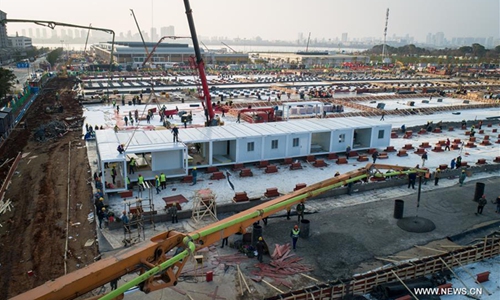HOME >> CHINA,SPECIAL-COVERAGE
China builds more SARS treatment-model hospitals to fight epidemic
Source:Xinhua Published: 2020/2/1 13:14:34

Aerial photo taken on Jan. 30, 2020 shows people from China Construction Third Engineering Bureau Co., Ltd. working at the construction site of Leishenshan (Thunder God Mountain) Hospital in Wuhan, central China's Hubei Province. Wuhan is building two hospitals to treat pneumonia patients infected with the novel coronavirus. As of Thursday noon, about 40 percent of the Leishenshan Hospital has been completed, and it is expected to be put into use on Feb. 5. (Xinhua/Xiao Yijiu)
More hospitals designed to replicate the SARS treatment model are popping up across China as the country mobilizes medical resources nationwide to contain the coronavirus outbreak.
Beijing has begun to renovate the city's Xiaotangshan Hospital, formerly used to quarantine and treat SARS patients, as a precaution in the face of the novel coronavirus outbreak.
Whether the hospital will be put into use will be based on the future development of the outbreak, officials said.
In the treatment and control of SARS, or Severe Acute Respiratory Syndrome, which spread rapidly on the Chinese mainland in 2003, Beijing built Xiaotangshan Hospital, a temporary medical center in the northern suburb of the city, in just a week.
The hospital admitted one-seventh of the SARS patients in the country within two months.
The hospital requires renovation due to some aging facilities and pipelines.
Now, several cities are building their own versions of Xiaotangshan.
Wuhan, for instance, is building two hospitals to treat patients infected with the novel coronavirus. The two facilities are expected to be put into use on Feb. 3 and Feb. 5, respectively, at the epicenter of the coronavirus outbreak in central China.
Workers, trucks and excavators are racing against the clock to meet the deadline at the construction sites.
At around 6 p.m. Wednesday, construction of power facilities concluded at Leishenshan (Thunder God Mountain) Hospital, one of the two Wuhan sites.
In only three days, more than 300 workers toiled around the clock to install and adjust 7-km-long high-voltage cables and 26 supporting facilities.
The hospital will accommodate 1,600 beds, 300 more than the previous design, as the number of local patients increases. It will expand to 60,000 square meters and provide working space to over 2,000 medical staff.
Meanwhile, more than 4,000 workers have been toiling away at the Huoshenshan (Fire God Mountain) Hospital site day and night. They have finished about 400 prefab rooms so far. Work is largely complete on the main pipeline of the drainage system at the hospital site.
More than 900 km away, dozens of bulldozers and cranes are working on a 3,000-square-meter plot of land for a hospital to isolate and treat patients infected with the coronavirus in the suburb of Fuzhou, capital of east China's Fujian Province.
The first phase will include an outpatient building and isolation wards with 200 beds. It will be ready for use on Feb. 2, said Liu Yunzhong, president of the construction company in charge of the project.
The second phase will cover an area of 5,100 square meters and work will be completed within 20 days, Liu said.
"We've mobilized over 100 workers to work in shifts to ensure round-the-clock construction," said Liu. "We are sparing no effort to build the hospital, and I am confident we can get the job done in time."
In northeast China's Heilongjiang Province, authorities have planned a similar hospital in the provincial capital Harbin, local authorities said on Thursday.
By Thursday, Heilongjiang had reported 59 confirmed cases, with 18 in Harbin.
The provincial government decided to transform the Hanan branch of the Second Affiliated Hospital, Heilongjiang University of Chinese Medicine, into one dedicated to treating patients infected by the novel coronavirus.
The hospital is in Pingfang District, Harbin city. It officially went into operation in 2016, with 500 beds and a floor space of 48,900 square meters.
Posted in: SOCIETY